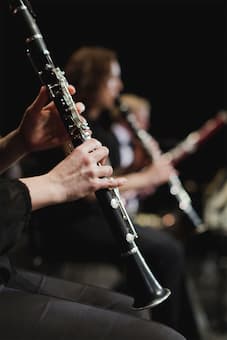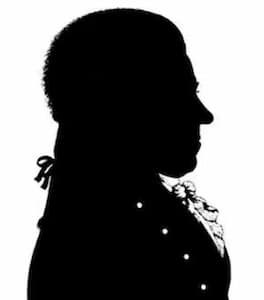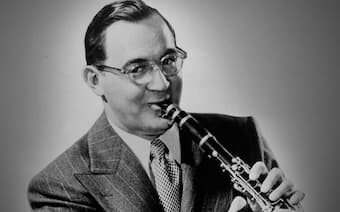
© Hybrid Images—Cultura/Getty Images
The clarinet often feels a bit left out when sitting next to its windy friends in the orchestra. There they all are, the flute, oboe, and bassoon, sitting high and mighty, all firm fixtures in the group when the new kid on the block turns up, relatively unheard of and having a lot to prove. Despite this, the clarinet took hold and went on to inspire composers to write some incredibly beautiful and innovative works that still inspire and delight today. Read on to discover some of the cornerstones of the clarinet’s classical repertoire.
Mozart: Clarinet Concerto (1791)

Silhouette of Anton Stadler © Bachtrack
It’s perhaps no surprise that at the top of the list sits Mozart’s Clarinet Concerto. Composed in 1791, just a few months before his death, the piece was written for clarinettist Anton Stadler, a performer with whom Mozart was well-acquainted throughout his life. Whether it’s the sublime slow second movement (highlighted in Sydney Pollack’s 1985 film Out of Africa), or the outer two movements that demonstrate the full expressive and technical range of the specially-modified basset clarinet for which it was composed, Mozart’s Clarinet Concerto is certainly an iconic part of the clarinet repertoire.
Students and professionals alike are driven to distraction practising the Concerto’s infamous opening phrase, the first movement being the standard set piece for many auditions. Despite this chagrin, we should also be incredibly grateful: it is one of the only clarinet concertos from the 18th century that is still regularly performed today, and the piece shows no signs of going anywhere anytime soon: the Concerto’s emotional scope, nifty virtuosity and sheer warmth makes it a firm audience favourite.
Copland: Clarinet Concerto (1947-1949)

Benny Goodman © Legacy.com
Skipping forward 150 years sees Aaron Copland injecting elements of jazz and bolstering a humble string orchestra with harp and piano to accompany the solo clarinet.
Written for soloist and bandleader Benny Goodman, the piece opens with a typical snapshot of Copland-brandTM American lushness, a lyrical melody soaring over widely-spaced string chords that give that open sense of optimism that Copland captures in his unique way. This soon gives way to a virtuosic cadenza that leads into the faster, more rhythmic second section of the piece. Here, jazz collides with modernistic dense harmonies, creating a thrilling tension that continues right through to the barnstorming finale.
Mozart: Clarinet Quintet (1789)
For some, it’s impossible to discuss Mozart’s Clarinet Concerto without also bringing to the table his Clarinet Quintet, written two years previously in 1789, again in collaboration with Anton Stadler.
Although of a smaller scale than his Concerto – featuring the solo clarinet and a modest string quartet as opposed to a full orchestra – the piece still takes us on a huge journey, from the serene opening chords of the first movement, through the suspended beauty of the second, the playful third and jovial fourth. This is perhaps a more intimate work than the Concerto due to the smaller number of performers on stage, but it still packs a punch and is often a staple of chamber music festivals due to its popularity with audiences.
Brahms: Clarinet Trio (1891)

Johannes Brahms and Richard Mühlfeld © Wikicommons
Another popular piece that remains a hit with audiences is Brahms’ Clarinet Trio. Written for the clarinettist Richard Mühlfeld in 1891, it is one of a small handful of pieces that features the combination of clarinet, cello, and piano. I love playing this piece, and find that this work epitomises Brahms’ ability to change the atmosphere of his music on a dime, one moment exuberant and triumphant, the next contemplative and brooding.
The dark tones of the cello and clarinet balance well in this work that dates from comparatively near the end of Brahms’ life. A little like Mozart, he went on a later-in-life clarinet composing spree, composing in the final years of his life this Trio, two Clarinet Sonatas, and…
Brahms: Clarinet Quintet (1891)
A roundup of famous clarinet pieces wouldn’t be complete without Brahms’ Clarinet Quintet, making him the second composer to get a double mention on the list.
This quintet, composed just over 100 years after Mozart’s, is another hallmark of the clarinet repertoire, filled with incredible beauty and tenderness that is pitted against anguish and struggle. Clocking in at about 35 minutes it’s no small undertaking (for both performer and listener), but it’s well worth the half-hour tour through four movements of bittersweet romanticism.
Of course, there are so many more brilliant pieces that exist for the clarinet – we’re lucky to have the range and depth of repertoire that we do. What are your standout favourites? Let us know which pieces deserve to be the audience staples of the future!
For more of the best in classical music, sign up to our E-Newsletter

